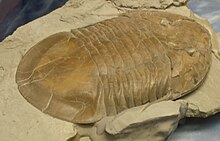Isotelus
| Isotelus | |
|---|---|
 |
|
| Isotelus brachycephalus | |
| Scientific classification | |
| Kingdom: | Animalia |
| Phylum: | Arthropoda |
| Class: | Trilobita |
| Order: | Asaphida |
| Superfamily: | Asaphoidea |
| Family: | Asaphidae |
| Genus: | Isotelus |
Isotelus is a genus of asaphid trilobite from the middle and upper Ordovician period, fairly common in the Northeastern United States, northwest Manitoba, southwestern Quebec and southeastern Ontario. One species, Isotelus rex, is currently the world's largest trilobite ever found as a complete fossil.
A specimen of Isotelus rex, from Churchill, Manitoba, is the largest complete trilobite ever found. Discovered by Dave Rudkin (Royal Ontario Museum), Robert Elias (University of Manitoba), Graham Young (Manitoba Museum) and Edward Dobrzanske (Manitoba Museum) in 1999, it measures 720 millimetres (28 in) in length, 400 millimetres (16 in) in maximum width (across the cephalon) and 70 millimetres (3 in) in maximum height (at the posterior midpoint of the cephalon).
Many specimens have also been found in Ohio, where Isotelus maximus is the state fossil.
...
Wikipedia
